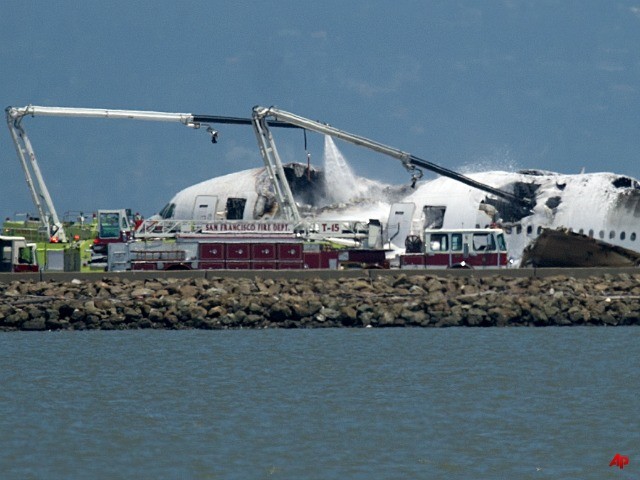(AP) Police: Teen in Asiana crash hit by fire truck
By TERRY COLLINS and JOAN LOWY
Associated Press
SAN FRANCISCO
One of the two Chinese teenagers killed in the Asiana Airlines disaster was hit by a fire truck while covered with firefighting foam, authorities said Friday, revealing a startling detail that suggested she could have survived the crash only to die in its chaotic aftermath.
However, it wasn’t clear whether Ye Meng Yuan, 16, was already dead when the collision occurred or whether the truck killed her moments after Saturday’s crash.
San Mateo County Coroner Robert Foucrault said the results of his initial inquiry into the deaths would likely be released sometime next week. The coroner said both bodies arrived directly from the airport. He would not comment on the police investigation.
Police said the teenager was on the ground and covered in foam that rescuers had sprayed on the burning wreckage of Flight 214. When the truck moved while battling the flames, rescuers discovered her body in the tire track, Esparza said.
Ye and her friend Wang Linjia, also 16, were memorialized Thursday at the Los Angeles Christian school that was their summer destination. Photos of the girls displayed at the memorial showed the pair with wide grins flashing peace sign. In one photo, they formed their arms into the shape of a heart.
The airliner collided with a rocky seawall just short the runway. Dozens of other passengers were injured, although most suffered only minor injuries.
Nearly a week after the crash, investigators have pieced together an outline of the accident. With each new bit of information, the picture that emerges is of pilots who failed to realize until too late that the aircraft was dangerously low and flying too slow.
Nothing disclosed so far by the National Transportation Safety Board investigators indicates any problems with the Boeing 777’s engines, computers or automated systems.
Investigators are still trying to nail down hundreds of details about the crash. NTSB Chairman Deborah Hersman has cautioned against drawing conclusions from the details released so far. But investigators already know a great deal.
They’ve listened to the Boeing 777’s voice recorder, which captured the last two hours of conversation in the cockpit. They’ve downloaded its flight data recorder, which captured 1,400 indicators of what was happening on the plane.
The flight’s four pilots have been interviewed, as have passengers and dozens of witnesses. Air traffic control recordings and video of the flight’s last moments, including the crash itself, have been examined.
According to details released so far, the pilot flying the plane, Lee Gang-kuk, 46, had nearly 10,000 hours of flying experience, but just 35 hours flying a Boeing 777. He had recently completed training that qualified him to fly passengers in the 777 and was about halfway through his post-qualification training.
He was seated in the left cockpit seat. In the co-pilot position was Lee Jeong-Min, an experienced captain who was supervising Lee Gang-kuk’s training. It was Lee Gang-kuk’s first time landing a 777 in San Francisco.
The weather at the time was nearly perfect, sunny with light winds.
Lee Jeong-Min and a third pilot sitting in a jump seat just behind the main seats, a first officer, were supposed to be monitoring the plane’s controls. One of their most important jobs was to closely monitor the plane’s two airspeed indicators.
The NTSB’s investigation is being followed closely by pilots in the U.S. and around the world. At one gathering of pilots in Dallas on Wednesday night, the discussion centered on why the Asiana pilots didn’t realize their low speed sooner. No one had an answer.
__
Associated Press writers Martha Mendoza and Jason Dearen contributed to this report.
Police: Teen in Asiana Crash Hit by Fire Truck

COMMENTS
Please let us know if you're having issues with commenting.